Martin P.M. Handbook of Deposition Technologies for Films and Coatings, Third Edition: Science, Applications and Technology
Подождите немного. Документ загружается.

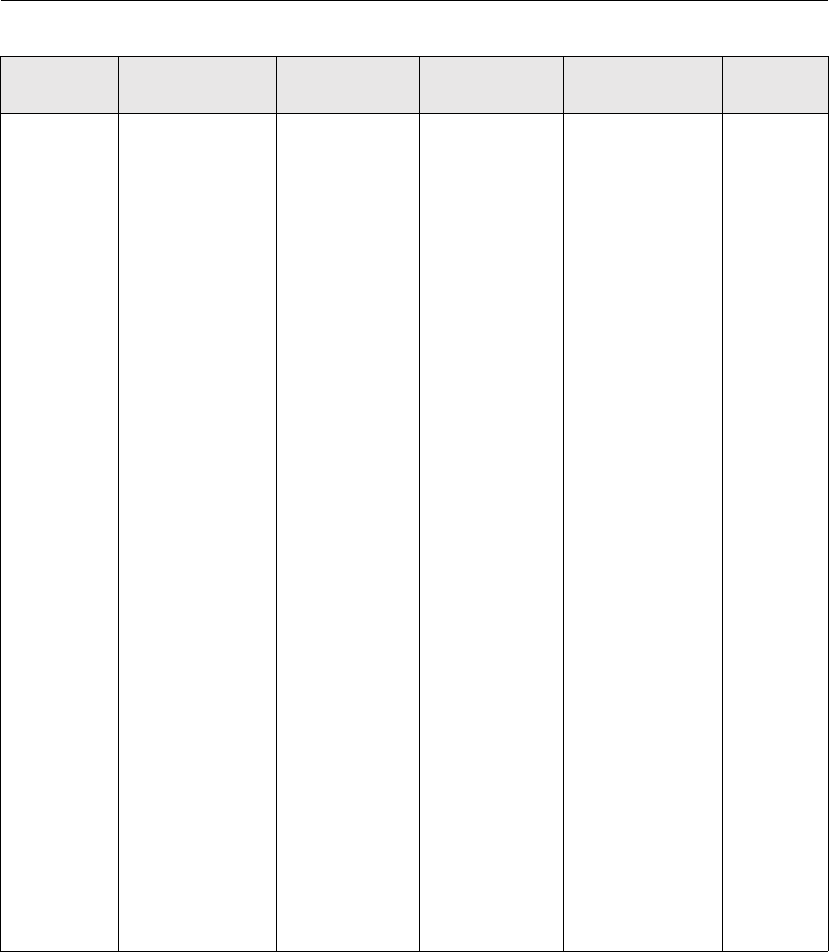
Glancing Angle Deposition 631
Table 13.1: Materials successfully deposited using GLAD
Material Deposition
method
Refs Material Deposition
method
Refs
Elements Nb
2
O
5
e-beam [34]
Aluminum Thermal, e-beam [30, 35, 36] SiO e-beam [37, 38]
Carbon IBS, PLD [39–41] SiO
2
e-beam [32, 42]
Chromium Thermal, sputter [38, 43] Ta
2
O
5
e-beam [44, 45]
Cobalt e-beam, thermal [46–49] TiO
2
e-beam [50, 51]
Copper Sputter [47, 52] TiZrV Sputter [53]
Germanium e-beam [54, 55] WO
3
Sputter, thermal [56–58]
Iron Thermal [25, 26, 59] Y
2
O
3
:Eu e-beam [60, 61]
Magnesium e-beam [62, 63] YSZ DVD, e-beam [64–66]
Nickel e-beam [67] ZnS e-beam [68]
Palladium Effusion [69] Zr
65
Al
7.5
Cu
27.5
e-beam [70, 71]
Platinum Sputter [72–74] ZrO
2
e-beam [75]
Ruthenium Sputter [74, 76]
Selenium Thermal [77] Organic
Silicon e-beam [41, 47] Alq
3
Thermal [78, 79]
Silver e-beam [80–82] C
60
Thermal [83]
Tantalum e-beam, sputter [84, 85] CuPc Thermal [86]
Tellurium Thermal [77] Parylene C Nozzle [87]
Titanium e-beam [88, 89] Pentacene Thermal [83]
Tungsten Sputter [47, 90] PPX Nozzle [91]
Znq
2
Thermal [92]
Inorganic
Al
2
O
3
e-beam [93, 94] Via templating
As
2
S
3
Thermal [95] Acrylates Spin-coating [96]
CaF
2
Thermal [97, 98] Copper Electroplating [99]
CeO
2
e-beam [100] Gold Electroplating [101]
CrN Sputter [102] HPR504 Spin-coating [103]
GeSbSn Thermal [104] LC Spin-coating [105]
HfO
2
e-beam [106] Nickel Electroplating [99, 101]
InN RIP [107] Polystyrene Melt infiltration [101]
ITO e-beam [32, 108, 109] Silicon LPCVD [110]
MgF
2
e-beam [42, 97] SOG Spin-coating [103]
DVD: directed-vapor deposition; e-beam: electron beam; IBS: ion-beam sputtering; LC: liquid crystal; PLD: pulsed-laser
deposition, RIP: radio-frequency ion-plating, SOG: spin-on glass.
motors, as seen in Figure 13.6. We note that the ability to orient the substrate such that α > π/2
is useful for shielding substrates from vapor flux during source conditioning, and that, in
practice, φ should be unbounded. It is also useful to be able to monitor the absolute angular
displacement of a substrate.
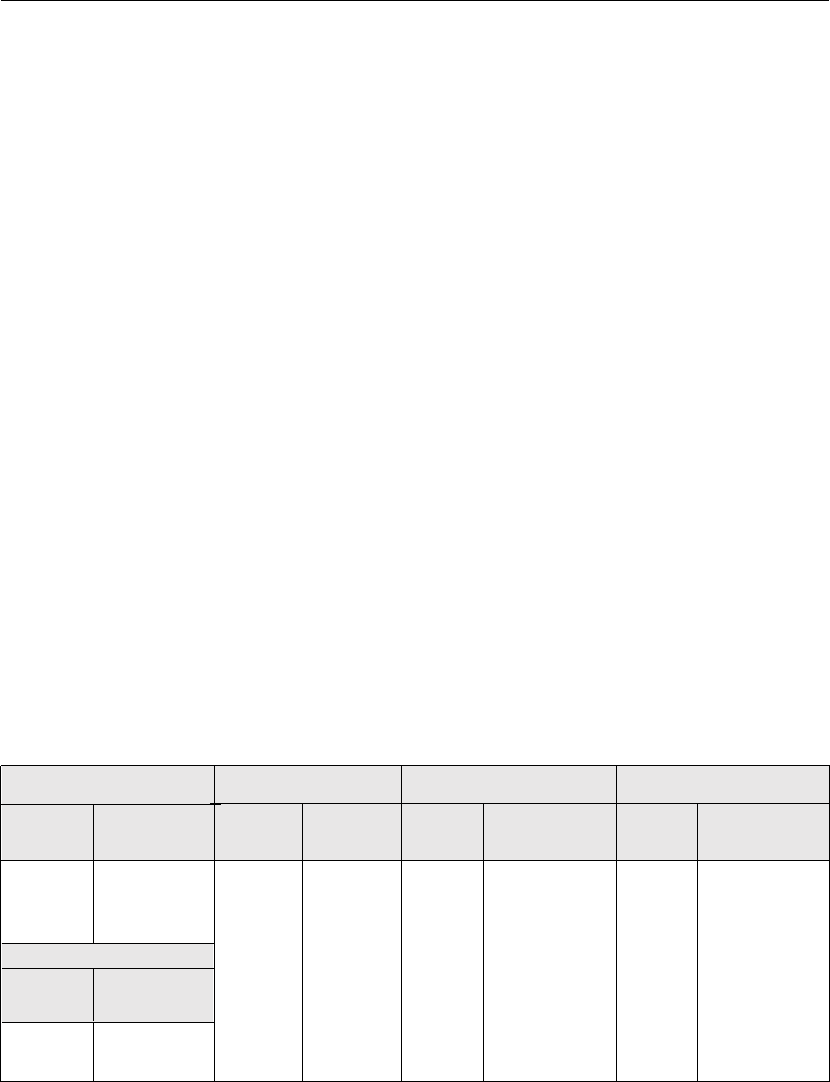
632 Chapter 13
13.2.3.4 Monitoring Requirements
Production of high-quality GLAD structures depends on in situ, real-time measurement of the
vapor flux plume to monitor deposition rate. For GLAD, deposition rate is defined as the
increase in film thickness per unit time at the center of a substrate with an orientation of (0, 0).
Monitoring deposition rate is typically accomplished with a crystal thickness monitor, and
must be used to modify substrate motion to better satisfy the substrate motion algorithm.
Optical in situ thickness monitoring methods are difficult in GLAD due to substrate motion,
and have not yet been demonstrated.
13.2.3.5 Substrate Motion Algorithm
To take full advantage of deposition rate monitoring, substrate motion for a particular structure
is defined as a series of ordered triplets. Each triplet defines a thickness (h
n
) above the
substrate, and a substrate orientation (α, φ) that should be satisfied when h
n
is reached. Linear
interpolation may be used between defined positions in the algorithm by the computer
controlling substrate motion. Table 13.2 gives sample algorithms. By defining a target height
h
n
, rather than deposition time, substrate motion can be corrected to respond to changes in
deposition rate, better matching the target structure.
The deposition rate is monitored by a crystal thickness monitor, and corrected for tooling to
report deposition rate at the center of a substrate oriented at (0, 0). However, this rate does not
correctly describe the vapor flux rate for an oblique substrate. The deposition rate must be
corrected to the substrate frame of reference to satisfy the substrate motion algorithm. The
deposition ratio is a function of α, defined as the ratio of thicknesses between a film deposited
Table 13.2: Examples of substrate motion algorithms
Slanted post Chevron Slanted post stack Bragg stack
Height (˛, ) Height (˛, ) Height (˛, ) Height (˛, )
(nm) (
◦
) (nm) (
◦
) (nm) (
◦
) (nm) (
◦
)
0 (80, 0) 0 (80, 0) 0 (85, 0) 0 (80, 0)
1000 (80, 0) 250 (80, 0) 200 (85, 0) 250 (80, 3600)
252 (80, 180) 202 (80, 180) 252 (60, 3600)
Vertical post 500 (80, 180) 300 (80, 180) 500 (60, 7200)
Height (˛, ) 502 (80, 0) 302 (75, 0) 502 (80, 7200)
(nm) (
◦
) 750 (80, 0) 700 (75, 0) 750 (80, 10800)
0 (80, 0) 752 (80, 180) 702 (65, 180) 752 (60, 10800)
1000 (80, 36000) 1000 (80, 180) 1000 (65, 180) 1000 (80, 14400)
The algorithms listed here will produce a film 1 m thick, and assume a deposition rate compatible with a substrate reorientation
within 2 nm of growth.

Glancing Angle Deposition 633
at an orientation of (α, 0) and a film deposited at (0, 0), assuming the same deposition rate and
deposition time. Using the deposition ratio, it is possible to convert from the vapor deposition
rate measured by the crystal thickness monitor to film height, as required.
As pointed out by Robbie et al., deposition ratios are not simply the expected cos α geometric
scaling from rotating the substrate [11]. As the substrate is tilted at more oblique angles, the
deposition ratio remains above the cos α dependence. This effect reflects the impact of
shadowing combined with limited surface diffusion. To produce high-quality GLAD
structures, a good understanding of a system’s deposition rate for a given material is required.
Calibration of deposition ratio can be performed by a series of depositions at different angles.
The resulting data can be fitted parametrically, or by equations such as those described by
Poxson et al. [32]. Substrate temperature can also affect deposition ratio through surface
diffusion rates. As a result, different deposition ratios may be observed for different layers of
multilayered structures as the temperature rises during deposition. Finally, column tilt angle
can vary in multilayered structures, as observed by Harris et al. [33]. Such changes produce a
change in deposition ratio, which must be corrected for high-quality structures.
13.2.4 Demonstrated Materials
Table 13.1 gives a selection of the materials that have been successfully deposited by GLAD.
Neither the list of materials nor references are exhaustive, serving only as a starting point for
the reader.
13.3 Advanced GLAD Processes
This section describes perturbations to the basic GLAD process described in Section 13.2.
This section is broken up into three subsections, describing advanced techniques that are
applied before, during, and after GLAD depositions. As we have seen in Section 13.2.2,
complex structures can be assembled using the basic canonical structures. Similarly, many of
the following techniques can be used in parallel, as they offer orthogonal improvements to the
basic GLAD process.
13.3.1 Predeposition Treatment: Substrate Seeding
The ballistic shadowing process responsible for producing GLAD structures begins with the
initial nucleation of deposited material. However, the nucleation process is random, and leads
to a distribution in column size and random locations on the substrate surface [111, 112].To
produce a film ordered in the substrate plane, it is necessary to circumvent the randomness of
nucleation. This may be achieved by introducing topography on the substrate surface, which
act as ‘forced’ nucleation sites. While such topography need not be periodic, some of the most
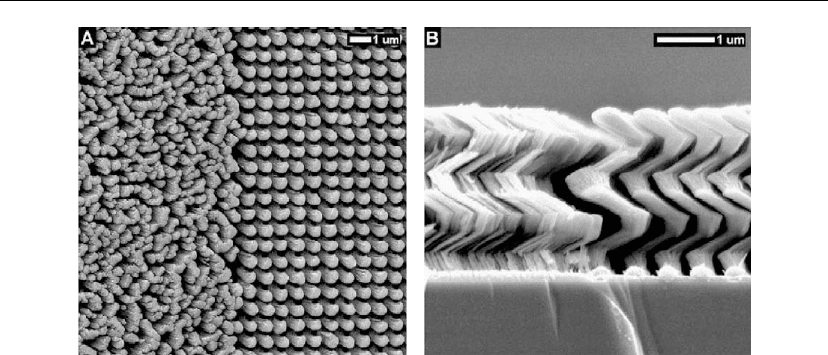
634 Chapter 13
Figure 13.7: (a) Top–down and (b) cross-section SEM images of a GLAD film deposited on a
substrate with an untreated (left side of both images) and seeded (right side of both images)
regions. With careful design of the seeds, forced nucleation can produce GLAD films that exhibit
ordering in the substrate plane. The individual GLAD columns are more uniform in the seeded
region due to reduction of competitive growth. (Reproduced with permission from [113], © 2005
IEEE.)
successful examples have been produced with periodic arrays. These features act as the initial
nucleation seeds for column growth.
With correct design of the shape, size, and spacing of these seeds, a single GLAD column will
grow at each lattice point. Consequently, column uniformity can be greatly improved by
reducing competitive growth. Figure 13.7 illustrates the difference between columns deposited
on a bare substrate and on an appropriate seed layer.
The first report of GLAD onto forced nucleation sites was by Malac et al., who used
electron-beam lithography to write features in PMMA resist [114]. Since then, many other
researchers have used several techniques to achieve forced nucleation, including
electron-beam lithography [85, 115–119], embossing [67], optical lithography [120–122],
laser-direct write lithography [113, 123], monolayers of colloidal crystals [124–137], and
block co-polymers [138]. While not yet demonstrated, the use of metal dot arrays fabricated
using a diffraction mask and laser ablation have also been proposed as seeds for GLAD
deposition [139]. In the following subsections, three rules of thumb for seed design are given,
followed by a description of a more rigorous simulation method for seed design. Finally,
advantages of the different seeding techniques used to date are discussed.
13.3.1.1 Seeding Theory
The first objective of forcing nucleation is to control the location of GLAD columns. This
requires that growth from forced nucleation sites dominates growth elsewhere. Thus, it is

Glancing Angle Deposition 635
desirable to maximize the incident vapor flux that deposits on the seeds, rather than allowing
flux to freely impinge on the substrate and nucleate at random. This consideration produces the
first rule of thumb for designing seeds. To prevent condensation between seeds for a given
deposition angle α, the following condition should be satisfied,
h tan α + d (13.4)
where is the center-to-center seed spacing, h is seed height, α is the deposition angle, and d
is seed width [113]. When this condition is exactly satisfied, a shadow cast from one seed will
just touch the base of a nearest neighboring seed. When the deposition plane is not aligned
with the seed array, shadowing will not be complete. In general, deposition on the sides of
seeds is not desirable, so should be slightly less than the right side of Eq. (13.4).
The second objective of forced nucleation is to minimize the extinction processes that arise
from competitive growth. The dependence of density on α in a GLAD film was discussed in
Section 13.2.1.4. Neglecting column broadening, the in-plane density will determine the bulk
density. The bulk density is determined by the macroscopic geometry of the deposition, and a
GLAD film can only be perturbed from this value for short periods. For circular seeds,
πd
2
4
2
≈
2cosα
1 + cosα
(13.5)
where , d and α are as defined in Eq. (13.4). The left-hand side of Eq. (13.5) is the fractional
area covered by the seeds, and the right side is Eq. (13.3), Tait’s equation for GLAD thin film
density. If the fractional area covered by the seeds does not approximately match the density
determined by the deposition angle α, the order initially imposed by forced nucleation will be
lost as the GLAD film returns to its equilibrium density.
However, it is insufficient to simply match the expected density of the GLAD film with the fill
fraction of the seeds. Equations (13.4) and (13.5) can be satisfied for any size of seed (d, h),
simply by adjusting the interseed spacing . In the limit, small seeds are equivalent to
substrate surface roughness and large seeds are equivalent to a smooth substrate. These effects
give rise to the third rule of thumb for seed design: seeds must be approximately equal in size
to the expected size of a single GLAD column. An example where this rule was violated is
given in Figure 13.8, where the seed size is larger than a single GLAD column, resulting in the
growth of multiple columns from each seed.
If requirements for column spacing and uniformity are severe, then the simple design rules
outlined above may be insufficient. In such cases, Summers has shown that a more rigorous
simulation can guide seed design and deposition conditions for demanding applications [110].
In this work, seed profiles were simulated using parametric equations which captured some
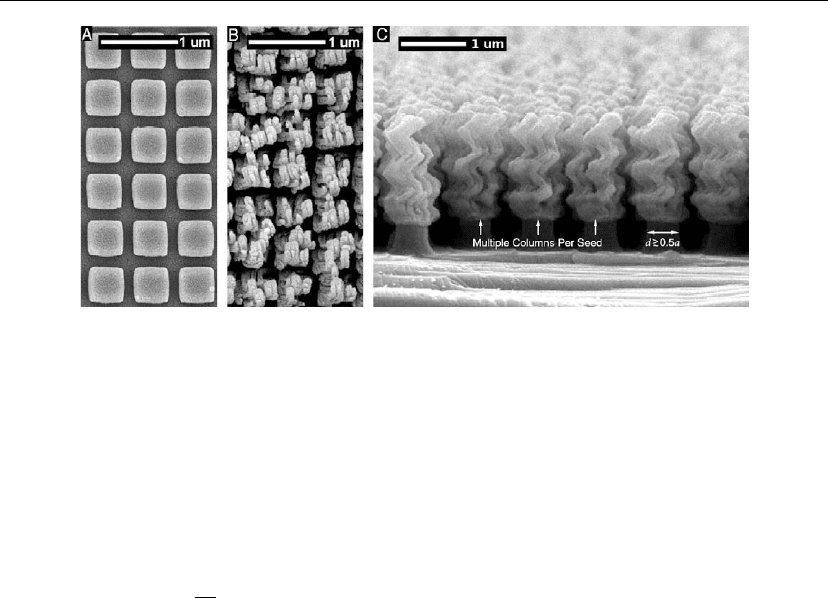
636 Chapter 13
Figure 13.8: Illustration of importance of matching seed size to GLAD column diameter. Here the
seeds (a) are much larger than the GLAD column diameter. Top (b) and side (c) views of multiple
columns per seed. Similar effects are noted for different materials (b) is Si, while (c) is SiO
2
.
((a, b) Reproduced with permission from [113], © 2005 IEEE, (c) reproduced with permission
from [110].)
typical profiles found in electron-beam lithography. Seed diameter is given by
D
(
s
)
= D
0
cos
πs
2
κ
(13.6)
where D is seed diameter, s is a height parameter which varies between 0 and 1, D
0
is the seed
diameter at the substrate, and κ is an exponent which controls seed curvature. By projecting
the shadow of such a seed, it is possible to calculate the area exposed to incoming vapor flux,
known as interstitial deposition. Summers and Brett have shown that the column broadening of
seeded GLAD structures improves as interstitial deposition is decreased [140]. As a result,
simulation of this quantity can be used as a proxy for GLAD column quality.
Summers simulated the interstitial deposition fraction as a function of offset angle, γ, for
several seed profiles, geometries, and deposition conditions [110]. This work was performed to
optimize an advanced deposition method, called PhiSweep, for deposition of square spiral
structures. Further details of the PhiSweep and related methods are given in Section 13.3.2.1.
Some results for a square lattice of seeds, with seed parameters determined empirically from
the work reported in [140], are presented in Figure 13.9. The expected decrease in interstitial
deposition with increasing deposition angle and increasing fractional area coverage is
observed. Moreover, the optimum offset angle is revealed by these simulations, and matches
the experimental result determined by Summers and Brett [140]. Such modeling efforts can be
extended to any seed profile or geometry, and used to determine the optimum deposition
conditions.

Glancing Angle Deposition 637
Figure 13.9: Interstitial deposition fraction as a function of (a) deposition angle and offset angle
(d = 0.49a, h = 0.166a, κ = 0.6), and (b) seed diameter and offset angle (α =85
, h = 0.166a,
κ = 0.6). The solid dots are experimental values from [140], and seed parameters were estimated
empirically from the same source. (Adapted from [110].)
13.3.1.2 Seeding Methods
One additional constraint on seed design is production method. Examples from the literature
are given in Figure 13.10. The previous design discussion has implicitly assumed that full
control of seeds is possible. In principle, this is true of the electron-beam lithography
[85, 115–119], laser direct-write lithography [113, 123], and optical lithography methods
[120–122], within the resolution limits of the respective techniques. The drawback to these
approaches is the long time required to produce a patterned substrate. While extremely
flexible, scaling to large substrate areas may not be possible. One method that may scale to
large substrate areas is embossing [67]. While embossing requires the use of a master, it
retains most of the flexibility of the lithography techniques, but should be much faster since
patterned substrate copies can be rapidly produced.
Figure 13.10: The first examples of the methods used to force nucleation in GLAD films: (a)
electron beam [114]; (b) colloidal crystals [127]; (c) embossing [67]; and (d) block co-polymers
[138]. ((a) Reprinted with permission from [114], © 1999 American Institute of Physics, (b)
reproduced from [127] with permission from Elsevier, (c) reprinted with permission from [67],
© 2001 American Chemical Society, (d) reproduced from [138].)

638 Chapter 13
The other methods for seeding substrates for GLAD growth use self-assembly, and trade
flexibility for speed. These include the use of colloidal crystals [124–131, 134, 135] and block
co-polymers [138]. Such techniques can produce very large areas, but are typically confined to
hexagonal geometries. Self-assembly techniques are also subject to crystal defects [130, 138,
141], which will adversely affect GLAD film column separation and broadening. An
additional limitation of the self-assembly methods is the fixed seed spacing. As seen from the
rules of thumb above, this is equivalent to reducing available deposition angles.
In practice, development of a seeding strategy might require several of these techniques in
series: electron-beam lithography to explore the parameter space, and embossing or nanoprint
lithography once the optimal conditions are understood. Forcing the nucleation of GLAD thin
films can be a powerful technique for controlling resulting film properties. However, it is best
used in combination with the advanced motion control techniques discussed in the next section.
13.3.2 Advanced Deposition Methods
In this section, we discuss modifications to the GLAD process during deposition, including
advanced motion control methods, GLAD co-deposition, and substrate temperature control.
13.3.2.1 Substrate Motion Control
Columns in GLAD films tend to broaden into fan-like shapes during deposition, which can
detrimentally affect film properties. To improve individual column structure, two techniques
based on dynamic shadowing have been developed. As discussed in Section 13.2.1, shadowing
is anisotropic, acting parallel to the deposition plane. Shadowing anisotropy may be reduced
by rotating the substrate, and thus the column shadow, during deposition. Active control of the
shadow forms the conceptual basis of the PhiSweep and substrate swing rotation techniques.
PhiSweep was introduced by Jensen and Brett [142]. The substrate motion in the PhiSweep
method is defined by a sweep angle γ and a sweep pitch, along with the standard α and φ
angles. The PhiSweep method, given schematically in Figure 13.11, deposits a thickness
defined by the sweep pitch at a substrate orientation of (α, φ + γ/2). The substrate is then
rotated to an orientation of (α, φ −γ/2) for a second segment, also equal to the sweep pitch.
Once deposition is complete, the substrate returns to the original position for another cycle.
These cycles are continued until the desired column length is obtained. Because of the
symmetry of the substrate sweep, the column’s net growth follows the central axis lying
between the two segments along an orientation defined by (α, φ).
Jensen and Brett have shown that the morphology of Si columns is very sensitive to the values
chosen for the PhiSweep method [142]. With a sweep pitch approximately equal to the column
diameter, the PhiSweep technique produces a film composed of densely packed individual
fibers 20–30 nm in width. It is thought that each change in substrate position acts as a new
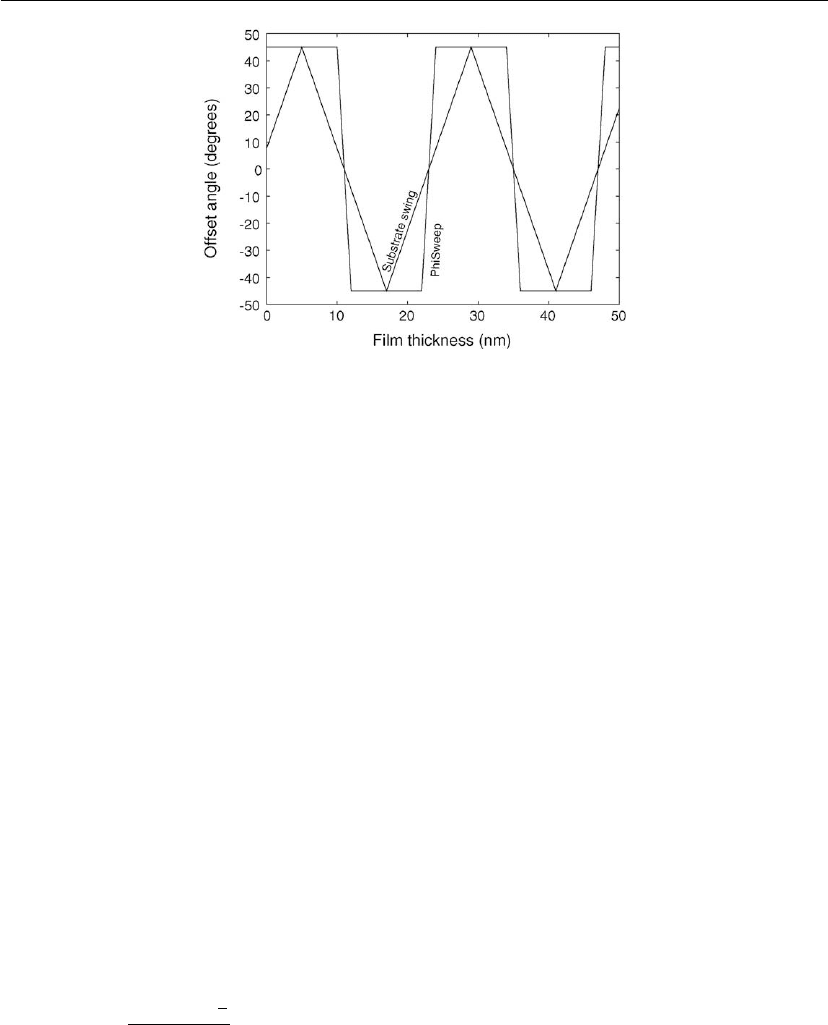
Glancing Angle Deposition 639
Figure 13.11: Offset angle as a function of thickness for the PhiSweep and substrate swing
motion algorithms. The step function is the PhiSweep motion, the sawtooth is the substrate
swing motion. Both algorithms will produce net column growth with an offset angle of 0
.
GLAD column, effectively suppressing the effects of competitive growth and column
broadening.
One effect of the PhiSweep technique is a change in the effective deposition angle. Gish et al.
have studied the β for PhiSweep columns deposited onto patterned substrates [143]. They have
shown that the tilt angle of the PhiSweep fibers PS is related to the tilt angle of the traditional
GLAD columns TG by
tan β
PS
= tan β
TG
cos γ (13.7)
Ye et al. introduced substrate swing rotation to eliminate anisotropic broadening in GLAD
structures [122]. Unlike the PhiSweep method, the substrate is periodically rotated through a
given angle (defined as swing angle φ). The motion of a substrate under this algorithm is also
shown in Figure 13.11. The effects of the substrate swing method on column morphology is
similar to that seen with the PhiSweep method. Column broadening is reduced, and column
chaining is prevented. As seen in Figure 13.12, better defined columns are achieved, with
approximately circular cross-sections in the plane of the substrate. As in the PhiSweep
method, periodic rotation of the substrate changes effective deposition angle, α
, given by
tan α
=
2 tan α sin
φ
2
φ
(13.8)
For both the PhiSweep and substrate swing methods, the column tilt angle β will deviate from
the expressions given in Section 13.2.1. The degree of deviation can be controlled using the

640 Chapter 13
Figure 13.12: Structures produced by the substrate swing method. Excellent column uniformity is
observed, and no broadening is observed. (Reproduced with permission from [122].)
analytic results of Eqs. (13.7) and (13.8). Both techniques offer an additional avenue for
controlling tilt angle, partially decoupling β from α. Another method for decoupling β from α
is the spin–pause method, developed by Robbie et al. [144]. In the spin–pause method, GLAD
structures are fabricated by combining the growth of vertical posts (spin) and slanted posts
(pause) in small segments. Although a constant α is maintained, varying the ratio of the spin
mode growth and pause mode growth produces a reduced β.
The PhiSweep and substrate swing methods were introduced to minimize anisotropy in the
planar cross-section of the columns. However, many physical properties of GLAD films are a
product of structural anisotropy in the substrate plane. Thus, it can be desirable to maximize
column broadening and enhance these properties. This has been achieved by Hodgkinson
et al., who developed serial bideposition (SBD) [145]. In SBD, deposition occurs at oblique
angles of incidence with rapid 180
◦
rotations of the substrate every few nanometers of growth.
In a plot like Figure 13.11, SBD would look like the PhiSweep method with an amplitude of
± 90
◦
and a period of a few nanometers. The time-averaged source direction is normal to the
substrate and the net growth of the structures will be in the vertical direction. The shadowing
mechanism is preserved, producing a highly pronounced structural anisotropy due to lateral
broadening perpendicular to the deposition plane. This has been exploited to produce films
with very high birefringence (see Section 13.5.1.1, Engineered birefringence). In a slanted
column, the planar cross-section is elliptical due to competition between two effects. The first,
broadening, orients the semi-major axis perpendicular to the deposition plane. The second,
column tilting, orients the semi-major axis parallel to the deposition plane.
The advanced substrate motion techniques described here have the effect of modifying the
available β for GLAD films. The trend for an unperturbed GLAD deposition is given by Tait’s
rule (Eq. 13.2). Column tilt angles below those predicted by Tait’s rule can be accessed
through the PhiSweep, substrate swing, SBD, and spin–pause methods. Column tilt angles
above those predicted by Tait’s rule are more difficult to obtain. The only method yet
